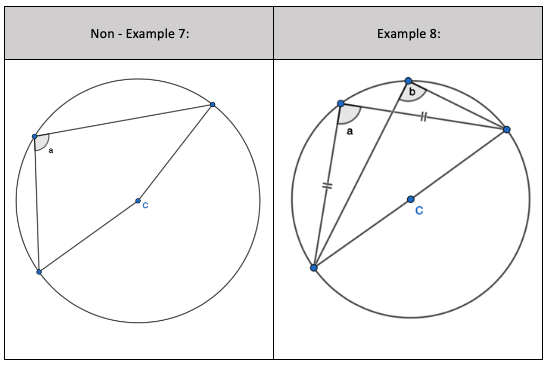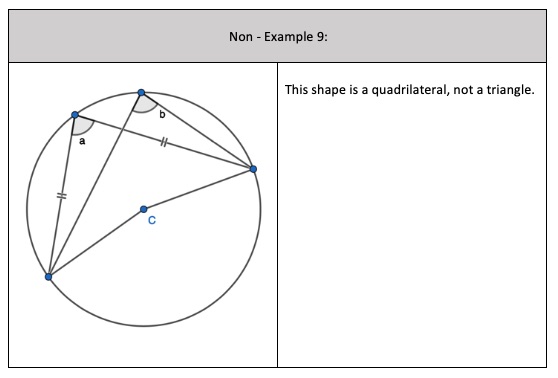In January 2017, I wrote two blog posts on a selection of circle theorem resources. I was in my fourth year of teaching and I loved creating curriculum resources. I made the problems using activinspire because I hadn’t mastered Geogebra by that point. There were so many mistakes in the questions.
Some lovely teachers got in touch via DM and gave their friendly feedback. Others wielded their axe and punched me with mean tweets. Some others pretended to care by writing blog posts about the situation. As if they knew the cause behind my errors.
It wasn’t the best of times. But, I learnt that it is OK to make mistakes that you didn’t even know were mistakes. It highlighted that subject knowledge development is never ending.
What have I learnt from the experience:
- Using GeoGebra meant that I was able to draw the angles, so a 26 degrees angle looked like one. The largest angle was opposite the longest side length etc.
- I was able to check that all the angles within a triangle and a straight line totalled to 180s. And that angles in a quadrilateral or around a point totalled to 360 degrees.
- I was able to learn about construction invariance – something I didn’t know about. It is also something taught after A level Mathematics. My knowledge of school taught mathematics goes this far.
- Always have your work reviewed by a fresh pair of eyes. Ask a friend, a colleague etc.
I am familiar with Geogebra and enjoy using the application. Last year I re-created the circle theorem resources into a prepared booklet. I will release each circle theorem’s resources one blog post at a time.
Here are a few things to know about the resources that you are about to see:
- The first section is showing pupils how the circle theorem comes into existence. Starting with the circle and outlining its features to deduce the circle theorem. If I showed this in class, then I would do this live rather than using static images.
- I then show a series of examples and non-examples of the circle theorem. This helps pupils to identify a circle theorem on complicated problems.
- I start with examples which model the circle theorem in insolation. So, a pupil’s attention is on the theorem alone and identifying the missing angle.
- I then start interleaving basic angle facts in the circle theorem problems. E.g: angles in a triangle, straight line, right angle, isosceles triangle etc.
- In future circle theorem resources, you will see me interleave learnt circle theorems. This is to build gradual difficulty within the examples.
- There is algebraic section included at the end where angles are expressions.
One common question I get from the resources I make: which sets are the resources appropriate for?
My answer: all sets!
This isn’t a popular answer but it’s true. When you are teaching a concept for the first time the teaching should be the same for all sets. The only difference between high and low attaining pupils is the time taken to learn the concept. High attaining pupils recall prior knowledge and using it with fidelity compared to weaker pupils. I would teach a new concept explicitly with all pupils across the attainment spectrum. Can you imagine your low-attaining pupils finding the missing angles on this problem?

Introducing the Circle Theorem: A right angle triangle in a semi-circle
Here is a circle:
Draw a line from one point on the circumference, through the centre of the circle marked ‘C’ through to the opposite end on the circumference. This line is the diameter:
Teacher Language: Edge – Centre – Edge – check it is a straight line!
Draw a straight line to another spot on the circumference in one half of the circle from one end of the diameter:
Complete the three-sided shape (triangle) by drawing a straight line between the two unconnected points:
We have a triangle that is within a circle, and all the triangle’s vertices are on the edge of the circle. In other words, all the triangle’s vertices are on the circumference on the circle. The angle on the circumference, not touching the diameter is 90 degrees. It is a right angle. This is a right-angle triangle.
Introducing Examples and Non-Examples
Specify the language to state the correct circle theorem example and its non-example.
For example:
“If we have the longest side of the triangle as the diameter of the circle, then we have a right-angled triangle.”
For a non-example:
“If the longest side of the triangle is NOT the diameter of the circle, then we don’t have a right-angled triangle.”
The right angle is always touching the circumference! ‘a’ in the examples mark the right angle:





Finding the missing angle using the circle theorem
At this point, I would state the steps to find the missing angle before looking at a few examples. Pupils can follow the steps if they lose track during the example explanation.
Here are the steps:
- Identify the right angle of the triangle
- Calculate the remaining interior angles by
- Adding the known angles
- Subtracting the result from 180 degrees
I usually do a ‘I do, We do’ set up when going through teacher examples. I will go through one example, and then pupils will go through a similar example. Same problem just different numbers. Completed on mini-whiteboards. Here is an example:
Example 1: Find the missing angles:

Here is the teacher sequence series only (‘I do’ only):



Example Breakdown:
- Circle theorem in Isolation – Find right angle and second missing angle
- Circle theorem in Isolation – Find right angle and second missing angle
- Interleave an Isosceles right-angled triangle
- Find the missing angles across two right-angle triangles. One being an Isosceles triangle.
- Same as example 4 but both triangles are in the same semi-circle
- Interleaving angles on a straight line
I included Example 5 to relate to a future circle theorem: Angles in the same segment are equal.
The algebraic section is incomplete. I thought I’d include it to see the variation theory applied in the examples.
Booklet: https://drive.google.com/drive/folders/1waAy8uS13nYNB-0s286cMLitxzWiV52O?usp=sharing
Leave a Reply
You must be logged in to post a comment.